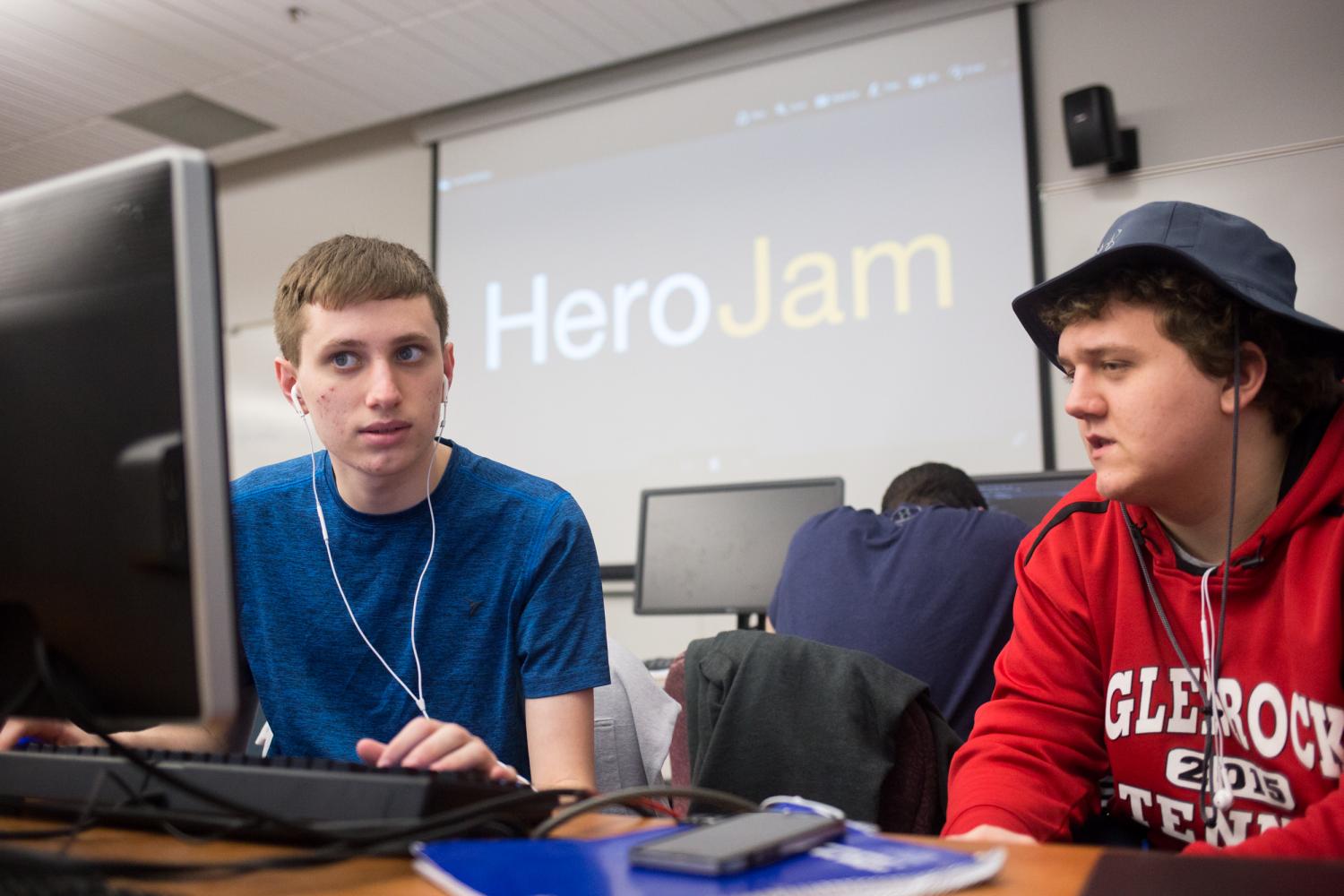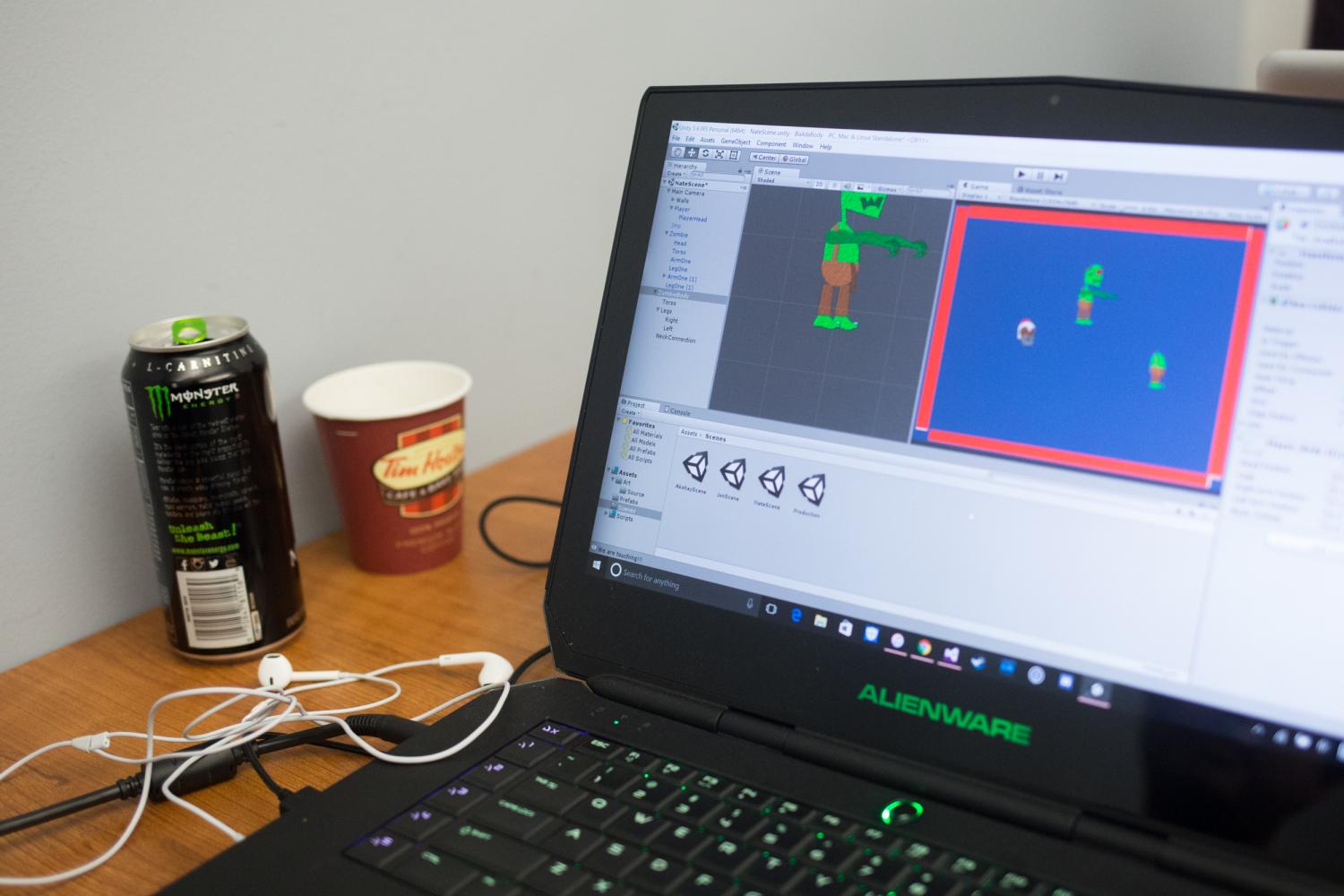HeroJam: Inaugural Game Jam Raises Money for Charity
by Ryan Black | published Apr. 26th, 2017
An opportunity for aspiring game developers to both test their skills and raise money for charity, the first ever HeroJam took place from March 31–April 2 this year. HeroJam was dedicated to helping improve the lives of kids in hospitals through charities like Child's Play and Children's Miracle Network Hospitals. Completely student-run, the 44 hour Game Jam took place right here at RIT's B. Thomas Golisano College of Computing.
Game Jam tasks its participants to conceive, design and program a functional game in about 24 to 48 hours. Given the limited amount of time, there are some implicit creative constraints. However, HeroJam’s founder Luke Miller — a third year Game and Design and Development student — noted how rewarding it can feel to create such projects.
“It’s usually pretty fun and you get a pretty good prototype out of it,” said Miller. “It is a lot of crunching and sometimes arguing and typically there is quite a few bashing ideas, but at the end of it it’s super satisfying to get to see what you just created.”
Miller noted how in the future he hopes to get specific themes from the kids supported by the event’s charities, but the inaugural HeroJam let participants build whatever game they wished to. At the end of the competition he, as well as Professors Steve Maier and Sten McKinzie of the School of Interactive Games and Media (IGM) in Golisano, determined the winners.
The Winners
The award for ‘Best Overall Game’ took into account factors such as game design, game-play and how fun the game was to play. The runner-up was "Easier-Zero" with the project "Uncheckers," developed by second year Game Design and Development majors Raymon Stempel, Nicholas Cato, Seth Leyens and Jackson Wootan.
Ultimately though, "Null Heroes" took home top prize for their game "FPS Finite Platform Shooter." Designed by first year Game Design and Development majors Dan Singer and Nick Marano, their game sought to combine elements from both first-person shooter (FPS) games and platformers.
“Our brainstorming went along the lines of genres that we like and play,” explained Marano. “And we came up with a FPS finite platform shooter.”
The game grants players the ability to generate platforms by aiming and shooting like they would in an FPS. Players have to then use their finite number of platforms to cross the level.
“It was pretty fun just working on one thing for a long time,” noted Singer. “It was kind of nice, you don’t have to balance other things, you just do this.” Neither had done a Game Jam before and were surprised themselves at how it turned out.
“I just wanted to try out new stuff,” said Marano. “I wasn’t expecting much of anything.”
"Plot Twist," a team of second year Game Design and Development students, won the award for Best Aesthetics with their game "Through the Night." The recognition takes into account the graphics, sound and overall design of the game made by
“It’s a 2D action game where you go through different rooms and you have to clear out all the enemies to get to the final boss,” described Gilbert, noting the game's nightmarish vibes and how it employs jump scares. “We had a dark aesthetic.”
The game’s premise is that you’re stuck in a dream where you have to fight off several nightmarish monsters. It was an art style chosen quite deliberately.
“So we kind of just were like, ‘Ok what can we do and what does Catherine like to draw?’ She was like, ‘Not people.’"
“We knew we had to be 2D because our artist [Nemechek] is good at 2D,” explained Weis. “So we kind of just were like, ‘Ok what can we do and what does Catherine like to draw?’ She was like, ‘Not people.’"
How HeroJam Came to Be
Between this being the first ever HeroJam and the circumstances surrounding its inception, organizing the event was quite the undertaking.
“This event actually came from Luke as a student wanting to do this,” pointed out Maier. “Luke is actually the one who spearheaded this."
“This event actually came from Luke as a student wanting to do this,” pointed out Maier. “It was a tough road to get going, but I think it was a good experience for knowing how to do this and knowing how much work is involved.”
Being the sole organizer, Miller had to ensure everything came together — all within two months.
“Feb. 1 I was told ‘hey this is the date, this is your timeframe, go do everything,’” recalled Miller. There ended up only being enough time to promote the event three weeks ahead of the competition. Miller used the term advertising "loosely" as the circumstances entailed him only being able to place a notice on a board and posting on Facebook.
Despite the minimal amount of publicity, that was almost entirely word-of-mouth, it only took four days to get 40 participants signed up. The competition was capped off for another week before they could open up more slots a week before the event. Miller noted how HeroJam then grew to 62 participants. There was a real interest for this sort of event.
“Game Jams are always really huge in the major and I think one of the problems that we have with a lot of them is they don’t get advertised very well,” said Miller. “Or at least they’re advertised in a way that kind of turns off students.”
Benefits of Game Jams
Events within Golisano like HeroJam and those of its ilk (including Hackathons) allow students to show how good they are outside of the classroom. Maier pointed how much Game Jams can really hone their skills, in a fashion that produces an actual game.
“Quite a few cool projects came out of it, some that I hope continue out of it,” said Miller. Both he and Maier made reference to how valuable prototypes and recognitions alike from Game Jams can be for younger students trying to make a name for themselves.
The members of "Plot Twist” explained how despite the fatigue from crunching for a full weekend, as well as the frustration from spending hours fixing bugs, HeroJam was a satisfying experience.
“If my body could handle it I would do a Game Jam every weekend.”
“You get 75 perfect of the way through and you feel so good because you are at a point where you could theoretically show the game now,” said Weis, adding that much of the enjoyment stems from realizing you did so much, in such a short period of time. “If my body could handle it I would do a Game Jam every weekend.”
HeroJam was also of course an event in support of charity. Through the event, over $800 was raised for Child’s Play, Children’s Miracle Network Hospitals and Golisano Children’s Hospital. For the past year Miller had been hoping to organize a greater number of philanthropic IGM events, particularly to benefit kids in hospitals.
“Childhood is one your very big developing moments,” said Miller. “And if you are stuck in a hospital for a month, a year or longer — you have only the hospital walls to look at, nothing really to do — it can be a pretty debilitating experience.”
“Plot Twist” noted how they thought adding charity to a Game Jam was a fitting match. They also would be even more excited to participate in future HeroJams should the kids supported by such charities choose the theme(s) next time around; it is something Miller has expressed a desire to do next time as well.
What’s to Come for HeroJam
The first HeroJam was a learning experience for both Miller and others within the college about the role of (and appetite for) Game Jams. Miller, for one, plans to have another HeroJam this Fall.
“When I have more than 60 days, it’ll hopefully be a lot better and I can do a lot more work on it,” he noted. “A lot more both advertising, sponsorship and preparation for it.”
Miller also expressed his hopes to see the number of participants grow next semester, possibly by opening entry to students from other colleges like Rensselaer Polytechnic Institute (RPI).
“We should also talk about how we want all the other departments to join in with us,” said McKinzie of the desire to make Game Jams more interdisciplinary by bringing in CIAS students and people from other colleges. The members of “Plot Twist” pointed out as well that you don’t even have to be a Game Design and Development student to take part in Game Jams.
“You don’t even have to come in knowing anything — you learn a lot more in Game Jams than you think you will,”
“You don’t even have to come in knowing anything — you learn a lot more in Game Jams than you think you will,” noted Weis. “You get to create a product
Growing the event empowers HeroJam to support more and more kids. However, while this semester's event was a first step in many ways, it still managed to get a number of future Game Designers to challenge themselves greatly — all in the name of a good cause.




